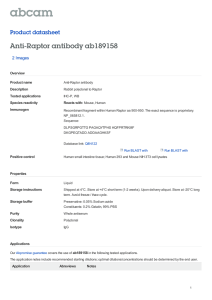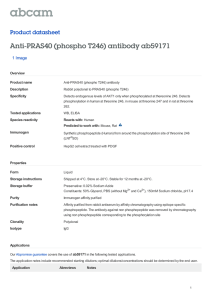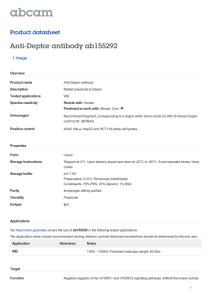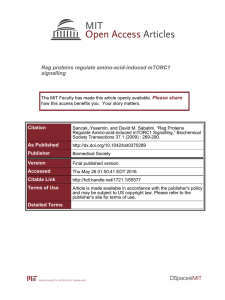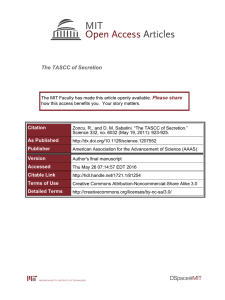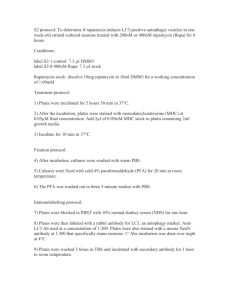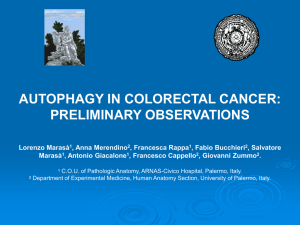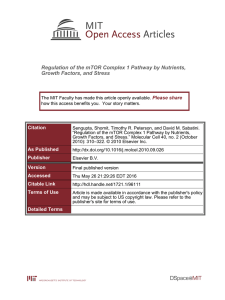Rapamycin inhibits mTORC1, but not completely Please share
advertisement
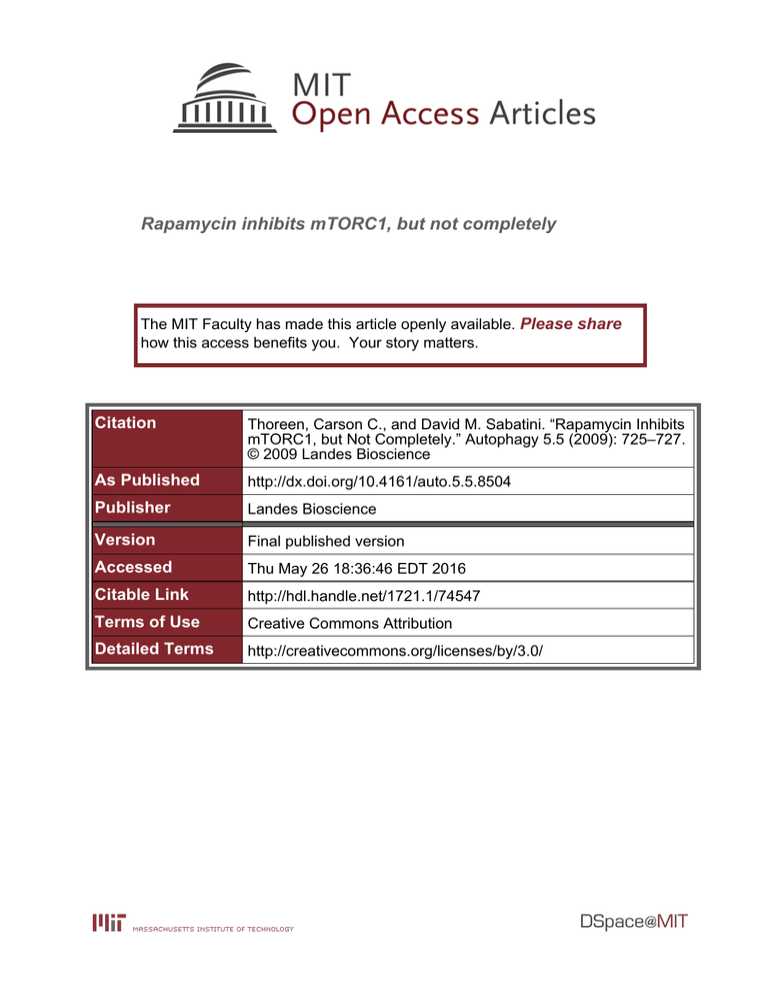
Rapamycin inhibits mTORC1, but not completely The MIT Faculty has made this article openly available. Please share how this access benefits you. Your story matters. Citation Thoreen, Carson C., and David M. Sabatini. “Rapamycin Inhibits mTORC1, but Not Completely.” Autophagy 5.5 (2009): 725–727. © 2009 Landes Bioscience As Published http://dx.doi.org/10.4161/auto.5.5.8504 Publisher Landes Bioscience Version Final published version Accessed Thu May 26 18:36:46 EDT 2016 Citable Link http://hdl.handle.net/1721.1/74547 Terms of Use Creative Commons Attribution Detailed Terms http://creativecommons.org/licenses/by/3.0/ [Autophagy 5:5, 725-726; 1 July 2009]; ©2009 Landes Bioscience Autophagic Punctum Rapamycin inhibits mTORC1, but not completely Carson C. Thoreen and David M. Sabatini* Whitehead Institute for Biomedical Research; Cambridge, MA USA Key words: mTORC1, mTOR, raptor, torin1, rapamycin resistance, rapamycin, autophagy, 4E-BP1, cap-dependent translation Rapamycin is widely used as a complete inhibitor of the mTORC1 nutrient-sensitive signaling complex. Using a novel ATP-competitive inhibitor named Torin1, we have found that many mTORC1 functions that regulate cap-dependent translation and autophagy are resistant to inhibition by rapamycin. Rapamycin is the canonical inhibitor of the mTOR (mammalian target of rapamycin) serine/threonine kinase. It was originally identified for its antifungal properties but later developed as an immunosuppressant and anticancer therapeutic. In mammalian cells, rapamycin acts through an allosteric mechanism that acutely disables the nutrient-sensitive mTOR complex 1 (mTORC1), one of two large protein kinases that share mTOR as the catalytic subunit. The second complex, mTORC2, is unaffected by acute rapamycin treatment. The response to rapamycin varies widely between cell types, though the drug generally slows proliferation and reduces cell size. In yeast, where many features of the mTOR pathway are conserved, the effects of rapamycin are much more severe and include cell cycle arrest, suppression of protein synthesis by almost 80% and robust induction of the autophagic recycling program. The discrepancy between these two systems has led many to conclude that mTORC1 fills a less prominent role in mammalian cells than the analogous complex does in yeast. However, using an ATP-competitive inhibitor named Torin1, we have made the surprising discovery that mTORC1 is an equally critical regulator of protein synthesis and autophagy, and that a significant subset of its functionality is resistant to inhibition by rapamycin. Rapamycin has been an indispensable tool for investigating the roles of mTORC1. Reasoning that a similar tool for mTORC2 would be equally useful, we developed an ATP-competitive small molecule mTOR inhibitor, which we call Torin1. Although Torin1 inhibits both mTOR complexes equally, we believed that we could distinguish mTORC2-specific phenotypes by comparing cells *Correspondence to: David M. Sabatini; Whitehead Institute for Biomedical Research; Cambridge, MA USA; Email: sabatini@wi.mit.edu Submitted: 02/10/09; Revised: 03/18/09; Accepted: 03/22/09 Previously published online as an Autophagy E-publication: http://www.landesbioscience.com/journals/autophagy/article/8504 Punctum to: Thoreen CC, Kang SA, Chang JW, Liu Q, Zhang J, Gao Y, Reichling LJ, Sim T, Sabatini DM, Gray NS. J Biol Chem 2009; 284:8023–32; PMID: 19150980; DOI: 10.1074/jbc.M900301200. www.landesbioscience.com treated with Torin1 to those treated with rapamycin. We began by measuring the effects of Torin1 on growth and proliferation. In mouse embryonic fibroblasts (MEFs), Torin1 caused a complete cell cycle arrest and reduced protein synthesis by almost 50%, while rapamycin had little effect. Torin1 also activated autophagy, as evidenced by lipidation of LC3 and its incorporation into cytoplasmic puncta. Protein synthesis and autophagy are more commonly associated with mTORC1 signaling, and so it was unexpected that Torin1 should affect them much more than rapamycin. Our first guess was that mTORC2 was also somehow influencing both processes. To confirm this hypothesis, we made use of MEFs lacking Rictor, a required mTORC2 component. These cells do not have a functional mTORC2 and so we expected that Torin1 and rapamycin would have equivalent effects, that is, the inhibition of mTORC1. Much to our surprise, the results of these experiments were identical to those from wild-type MEFs. Even in these cells, Torin1 continued to suppress protein translation and robustly activate autophagy to a greater extent than rapamycin, indicating that some functions of mTORC1 were blocked by Torin1 but resistant to rapamycin (Fig. 1). Because Torin1 suppressed protein synthesis so dramatically, it seemed likely that rapamycin resistance would be mediated, at least in part, by an mTORC1 effector that connected to the translational machinery. The best studied of these are the two mTORC1 substrates S6K and 4E-BP1, both of which influence different aspects of cap-dependent translation. S6K activity, however, is completely inhibited by rapamycin, ruling out any rapamycin-resistant role for it. In contrast, 4E-BP1 is subject to a more complicated regulatory mechanism that is governed by phosphorylation at 4 sites, Thr36, Thr47, Ser65 and Thr70. While rapamycin suppressed phosphorylation of Ser65, Torin1 caused a complete dephosphorylation of Thr36, Thr47 and Ser65, indicating that 4E-BP1 mediates at least some of the rapamycinresistant functions of mTORC1. RNAi depletion of Raptor, a required mTORC1 component, had similar effects and confirmed that Torin1 was acting specifically through inhibition of mTORC1 rather than inhibition of just mTOR or an unknown mTORcontaining complex. Because rapamycin is commonly used to determine whether mTORC1 influences a particular process, many real, but rapamycin-resistant, connections may have been dismissed. A good example is autophagy, which is strongly activated by rapamycin in Autophagy 725 Rapamycin inhibits mTORC1, but not completely yeast but only mildly in mammalian cells. Consequently, many have concluded that mTORC1 is not a major regulator of this process in mammalian cells. Our results suggest otherwise. In yeast, rapamycin is thought to drive autophagy by inhibiting the phosphorylation of Atg13, which then binds to and activates the serine/threonine kinase Atg1. It is tempting to wonder whether mTORC1 engages a similar, although rapamycin-resistant, mechanism in mammalian cells. There are two known mammalian homologues to Atg1 named Unc51-like kinase 1 and 2 (ULK1/2), and a putative Atg13 homologue (KIAA0652) that was recently identified by Tooze and colleagues. Although we can only speculate at the moment, it would not be surprising if mTORC1 acts similarly to TORC1 and regulates autophagy by phosphorylating KIAA0652 and thereby regulating ULK1/2. The finding that mTORC1 has rapamycin-resistant functionality also has implications for the treatment of diseases characterized by hyperactive mTORC1 signaling. For instance, tuberous sclerosis complex (TSC) is a hamartomous disorder caused by genetic inactivation of an upstream inhibitor of mTORC1. Although rapamycin is currently in clinical trials as a treatment for TSC, our work suggests that it may not reverse all of the consequences of hyperactive mTORC1 and that a more complete mTORC1 inhibitor might have more success. mTORC1 is also a primary effector downstream of the PI3K/PTEN signaling pathway, which is mutationally hyperactivated in most cancers. Although there has been considerable enthusiasm for rapamycin as a therapeutic for this class of diseases, they, too, might be more responsive to complete mTOR inhibition. Despite uncovering a significant feature of mTORC1 signaling, we have made little progress on our original quest, which was to understand the effects of pharmacologically inhibiting mTORC2. Thus far, the consequences of Torin1 treatment appear to largely reflect inhibition of mTORC1, leading us to wonder whether mTORC2-related phenotypes might be masked. If this is the case, understanding pharmacological inhibition of mTORC2 will likely require the development of an mTORC2-specific inhibitor. Because both mTOR complexes share the same catalytic domain, such an inhibitor would need to act allosterically, a difficult though not insurmountable barrier. Given the fundamental role that both mTOR complexes play in normal and diseased physiology, and recent work from our lab showing that mTORC2 is required for the initiation of at least some PTEN-driven cancers, a specific mTORC2 inhibitor would undoubtedly be a valuable addition to our investigational tool kit. 726 Figure 1. Rapamycin completely inhibits some mTORC1 functions but not others. Rapamycin completely inhibits mTORC1-dependent phosphorylation of S6K, but only partially affects phosphorylation of 4E-BP1 and activation of autophagy. Other functions may exist that are mTORC1dependent but are completely unaffected by rapamycin. Autophagy 2009; Vol. 5 Issue 5
